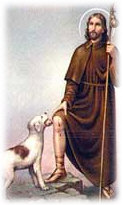



Confessor, fourteenth century
We celebrate the feast each year around the third week of August
In the later Middle Ages, when outbreaks of the plague were frequent and dreaded occurrences, Saint Roch was widely invoked for protection against the disease. He was born in Montpellier in southern 'France, about the beginning of the fourteenth century, and evidently spent most of this life nursing victims of the plague. Reliable information about him in scarce, although various legends and stories have supplied him with a detailed history.
According to some of the more trustworthy of these accounts, Roch was the son of Montpellier's governor. At the age of twenty he began a pilgrimage to Rome,, after first selling his inheritance and giving the money to the poor. Finding the plague raging in all the Italian towns he passed through, he began caring for those afflicted with it. Few people at that time had the courage to face the disease, much less to help who had it. Besides being revolting to see, the plague was swift-working, easily transmitted, and nearly always fatal. Those who contracted it frequently found themselves abandoned and left to die alone. In such a fear-stricken atmosphere. Roch went from city to city devotedly nursing those who had the disease. Often, it is said, he cured his patients simply by making the sign of the cross over them.
At Piacenza, his self-sacrifice had its inevitable result; he became afflicted with the plaque himself. Knowing from experience how other would react to his condition, he went to a nearby forest to die quietly and alone. The legends tell us, however, that he was kept alive by bringing him a loaf of bread every day. The dog's master followed it on one occasion, found Roch, and cared for him until he recovered. After more work among the plaque-stricken, Roch finally returned to Montpellier, many years after he had left there. The city was engaged in a war, and Roch, whom no one recognized, was taken for a spy and thrown into prison. He died there, still unrecognized, five years later. When his body was examined after his death, a cross-shaped birthmark on his breast enabled him to be identified as the governor's son. One evidence of the widespread devotion to Roch are the many paintings of him; he is usually shown with a pilgrim's staff, a dog at his feet and a sore--the mark of the plaque- showing on his thigh.